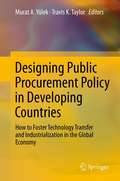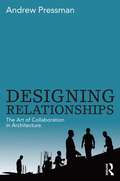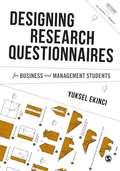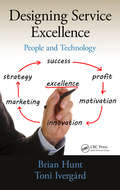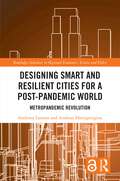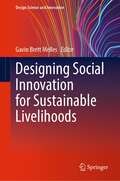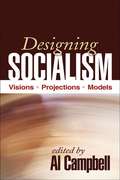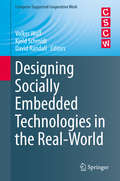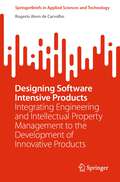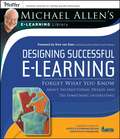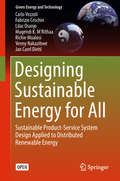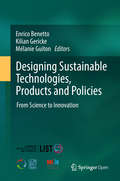- Table View
- List View
Designing Public Procurement Policy in Developing Countries
by Travis K. Taylor Murat A. YülekThis book presents effective strategies for developing countries to leverage their public sector demand for manufactured imports to promote industrialization, trade, and technology transfer. Technology transfer and its absorption is considered one of the most crucial and complicated challenges for developing countries, which are characterized by insufficient infrastructure, low technological intensity of the domestic capital stock, and high levels of manufactured imports. Which strategies and policy tools can governments employ to link demand with technology transfer, thereby enhancing absorption capacity and development in emerging economies? This book is part of a broader project launched by PGlobal Global Advisory and Training Services Ltd., in cooperation with Istanbul Commerce University (İTUCU) and the Scientific and Technological Research Council of Turkey (TÜBİTAK). The contributors to this book are policymakers, academicians, and experts who are working together to identify problems and develop policy recommendations for public procurement with respect to economic development. The book includes theoretical, empirical, and case study analyses of technology transfer mechanisms, public procurement policies, and countertrade and offset strategies. The lessons learned from these chapters will be of interest to both academics and policymakers concerned with technology transfer, industrial policy, and economic development.
Designing Reality: How to Survive and Thrive in the Third Digital Revolution
by Neil Gershenfeld Alan Gershenfeld Joel Cutcher-GershenfeldThat's the promise, and peril, of the third digital revolution, where anyone will be able to make (almost) anythingTwo digital revolutions--computing and communication--have radically transformed our economy and lives. A third digital revolution is here: fabrication. Today's 3D printers are only the start of a trend, accelerating exponentially, to turn data into objects: Neil Gershenfeld and his collaborators ultimately aim to create a universal replicator straight out of Star Trek. While digital fabrication promises us self-sufficient cities and the ability to make (almost) anything, it could also lead to massive inequality. The first two digital revolutions caught most of the world flat-footed, thanks to Designing Reality that won't be true this time.
Designing Regulatory Policy with Limited Information (Harwood Fundamentals Of Pure And Applied Economics Ser.)
by D. Besanko D. SappingtonExamines policy design when the policy maker in imperfectly informed, focusing on cases where the regulated firm possesses better information about its technology than the regulator.
Designing Relationships: The Art Of Collaboration In Architecture
by Andrew PressmanIn today’s dynamic practice environment, collaboration and teamwork skills are increasingly critical to the successful completion of building projects. Indeed, it is the careful nurturing of comradeship among complementary but distinctive egos that drives creativity underlying the hi-tech algorithms that help shape complex projects. Designing Relationships: The Art of Collaboration in Architecture focuses on the skill set necessary to facilitate effective teamwork and collaboration among all stakeholders no matter what project delivery mode or technology is deployed. This book provides valuable guidance on how to design and construct buildings in a team context from inception to completion. It is the less tangible elements of collaboration and teamwork that provide the magic that transforms the most challenging projects into great works of architecture, and it is these more nuanced and subtle skills which the book brings to the fore. Showing examples of best and worst practice to illustrate the principles with real-life situations, this book presents the reader with an approach that is flexible and applicable to their everyday working life.
Designing Research Questionnaires for Business and Management Students (Mastering Business Research Methods)
by Yuksel EkinciIn Designing Research Questionnaires, Yuksel Ekinci guides you through origins, types of questionnaire, basic components, types of questions and properties of measurement scales, how to design a questionnaire, sequence of questions, layout decisions and pilot testing, examples and strengths and limitations. Ideal for Business and Management students reading for a Master’s degree, each book in the series may also serve as reference books for doctoral students and faculty members interested in the method. Part of SAGE’s Mastering Business Research Methods Series, conceived and edited by Bill Lee, Mark N. K. Saunders and Vadake K. Narayanan and designed to support researchers by providing in-depth and practical guidance on using a chosen method of data collection or analysis. Watch the editors introduce the Mastering Business Research Methods series.
Designing Research Questionnaires for Business and Management Students (Mastering Business Research Methods)
by Yuksel EkinciIn Designing Research Questionnaires, Yuksel Ekinci guides you through origins, types of questionnaire, basic components, types of questions and properties of measurement scales, how to design a questionnaire, sequence of questions, layout decisions and pilot testing, examples and strengths and limitations. Ideal for Business and Management students reading for a Master’s degree, each book in the series may also serve as reference books for doctoral students and faculty members interested in the method. Part of SAGE’s Mastering Business Research Methods Series, conceived and edited by Bill Lee, Mark N. K. Saunders and Vadake K. Narayanan and designed to support researchers by providing in-depth and practical guidance on using a chosen method of data collection or analysis.
Designing Service Excellence: People and Technology
by Brian Hunt Toni IvergardThe moment of truth-that instant when consumers experience and judge service quality-is often a deciding factor in business success. Designing Service Excellence: People and Technology provides practical information on the design, management, and organization of many different types of service industries, such as hotels, restaurants, banks and fina
Designing Service Machines: Translating Principles of System Science to Service Design (Translational Systems Sciences #15)
by Ram Babu Roy Paul Lillrank Sreekanth V. K. Paulus TorkkiThis book presents a general conceptual framework to translate principles of system science and engineering to service design. Services are co-created immaterial, heterogeneous, and perishable state changes. A service system includes the intended benefit to the customer and the structure and processes that accomplish this benefit. The primary focus is on the part of the service system that can reproduce such processes, called here a Service Machine, and methodological guidelines on how to analyze and design them. While the benefit and the process are designed based on the domain knowledge of each respective field, service production systems have common properties. The Service Machine is a metaphor that elicits the fundamental characteristics of service systems that do something efficiently, quickly, or repeatedly for a defined end. A machine is an artifact designed for a purpose, has several parts, such as inputs, energy flows, processors, connectors, and motors assembled as per design specifications. In case of service machine, the components are various contracts assembled on contractual frames. The book discusses Emergency Medical Services (EMS) and Emergency Departments (ED) as cases. They illustrate that service machines need to be structured to adapt to the constraints of the served market acknowledging the fact that services are co-created through the integration of producers’ and customers’ resources. This book is highly recommended for those who are interested in understanding the fundamental concepts of designing service machines.
Designing Smart Prices: Kundenwahrnehmung von Dynamic und Personalized Pricing (Beiträge zur empirischen Marketing- und Vertriebsforschung)
by Mila VogelsangDie intelligente, algorithmenbasierte Preisgestaltung, das sogenannte Smart Pricing, ist zu einer wichtigen Säule bei der Entwicklung neuer Preisstrategien geworden. Sowohl die Praxis als auch wissenschaftliche Studien indizieren, dass diese Form der Preisgestaltung zu einer signifikanten Umsatz- und Gewinnsteigerung beitragen kann. Diese Buch leistet sowohl in theoretischer als auch in praktischer Hinsicht ein tiefergehendes Verständnis für Smart Pricing, im Speziellen Dynamic und Personalized Pricing, und zeigt wichtige Erklärungs- und Lösungsansätze auf, wie diese innovativen Preisstrategien systematisch gestaltet werden sollten.
Designing Smart and Resilient Cities for a Post-Pandemic World: Metropandemic Revolution (Routledge Advances in Regional Economics, Science and Policy)
by Anthony Larsson Andreas HatzigeorgiouAre pandemics the end of cities? Or do they present an opportunity for us to reshape cities in ways making us even more innovative, successful, and sustainable? Pandemics such as COVID-19 (and comparable disruptions) have caused intense debates over the future of cities. Through a series of investigative studies, Designing Smart and Resilient Cities for a Post-Pandemic World: Metropandemic Revolution seeks to critically discuss and compare different cases, innovations and approaches as to how cities can utilise nascent and future digital technology and/or new strategies in order to build stronger resilience to better tackle comparable large-scale pandemics and/or disruptions in the future. The authors identify ten separate societal areas where future digital technology can impact resilience. These are discussed in individual chapters. Each chapter concludes with a set of proposed "action points" based on the conclusions of each respective study. These serve as solid policy recommendations of what courses of action to take to help increase the resilience in smart cities for each designated area. Securing resilience and cohesion between each area will bring about the metropandemic revolution. The book features a foreword by Nobel laureate Peter C. Doherty and an afterword by Professor of Urban Technologies, Carlo Ratti. It provides fresh and unique insights on smart cities and futures studies in a pandemic context, offers profound reflections on contemporary societal functions and the needs to build resilience and combines lessons learned from historical pandemics with possibilities offered by future technology.
Designing Social Innovation for Sustainable Livelihoods (Design Science and Innovation)
by Gavin Brett MellesThis volume discusses how design broadly understood as design of business, policy, product, system, etc. can produce socially responsible innovations with livelihoods consequences. Sustainable Livelihoods Framework (SLF) is a robust framework for analysing and measuring social impact for excluded populations and groups. This is illustrated with case studies from India, Sri Lanka, Bangladesh, Nepal by discussing how initiatives concerned with design in the broad sense have the potential to create sustainable livelihoods. This volume will be of interest to scholars and practitioners in Sustainable Development and Design.
Designing Socialism
by Al CampbellThis highly readable volume explores what contemporary models of socialism have to offer for envisioning a better world and developing feasible alternatives to neoliberalism and pervasive inequality. The book is organized around clearly stated questions that capture core issues and debates. Concise contributions from leading thinkers address the theoretical and historical justification for socialism, what a socialist society would look like, how self-interest and the interests of society can be reconciled, the stages and productive forces of socialism, and how socialist growth differs from capitalist growth. Two related book reviews are included. This volume was originally published as a special issue of Science & Society (Vol. 76, No. 2, 2012), editor, David Laibman, PhD.
Designing Socially Embedded Technologies in the Real-World
by David Randall Volker Wulf Kjeld SchmidtThis book is concerned with the associated issues between the differing paradigms of academic and organizational computing infrastructures. Driven by the increasing impact Information Communication Technology (ICT) has on our working and social lives, researchers within the Computer Supported Cooperative Work (CSCW) field try and find ways to situate new hardware and software in rapidly changing socio-digital ecologies. Adopting a design-orientated research perspective, researchers from the European Society for Socially Embedded Technologies (EUSSET) elaborate on the challenges and opportunities we face through the increasing permeation of society by ICT from commercial, academic, design and organizational perspectives. Designing Socially Embedded Technologies in the Real-World is directed at researchers, industry practitioners and will be of great interest to any other societal actors who are involved with the design of IT systems.
Designing Software Intensive Products: Integrating Engineering and Intellectual Property Management to the Development of Innovative Products (SpringerBriefs in Applied Sciences and Technology)
by Rogerio Atem de CarvalhoThis book guides the reader through a design process that was tested and optimized in companies and design bureaus. It not only smoothly integrates modern product development techniques, but also addresses, for each phase, issues related to the management of intangible assets. There are several books on the product design process, as well as on the development of innovative products in general. However, none of them addresses how to integrate the engineering techniques with the necessary aspects of Intellectual Property Management. With a focus on software intensive products in general, the book presents a meta-process that adapts to product design in any area where the software element is an important factor in product functionality and innovation.
Designing Specific Growth Initiatives: A Discovery-Driven Approach
by Ian C. Macmillan Rita Gunther McgrathOnce corporate leadership has defined what success should look like for the whole portfolio of new initiatives it will be pursuing, the next step is to flesh out discovery-driven plans for each of the major initiatives. This chapter shows you how to connect your growth strategy and internal processes to your specific strategic initiatives and provides an example of how to start a discovery-driven plan. This chapter is excerpted from "Discovery-Driven Growth: A Breakthrough Process to Reduce Risk and Seize Opportunity."
Designing Suburban Futures
by June WilliamsonSuburbs deserve a better, more resilient future. June Williamson shows that suburbs aren't destined to remain filled with strip malls and excess parking lots; they can be reinvigorated through inventive design. Drawing on award-winning design ideas for revitalizing Long Island, she offers valuable models not only for U. S. suburbs, but also those emerging elsewhere with global urbanization. Williamson argues that suburbia has historically been a site of great experimentation and is currently primed for exciting changes. Today, dead malls, aging office parks, and blighted apartment complexes are being retrofitted into walkable, sustainable communities. Williamson shows how to expand this trend, highlighting promising design strategies and tactics. She provides a broad vision of suburban reform based on the best schemes submitted in Long Island's highly successful "Build a Better Burb" competition. Many of the design ideas and plans operate at a regional scale, tackling systems such as transit, aquifer protection, and power generation. While some seek to fundamentally transform development patterns, others work with existing infrastructure to create mixed-use, shared networks. Designing Suburban Futures offers concrete but visionary strategies to take the sprawl out of suburbia, creating a vibrant, new suburban form. It will be especially useful for urban designers, architects, landscape architects, land use planners, local policymakers and NGOs, citizen activists, students of urban design, planning, architecture, and landscape architecture.
Designing Successful Target-Date Strategies for Defined Contribution Plans: Putting Participants on the Optimal Glide Path (Wiley Finance #594)
by Stacy L. SchausThe ultimate guidebook for navigating the new world of pensions and retirement plans In the wake of the explosive growth of defined contribution (DC) plans invested with target date strategies, and the understanding of how important these strategies can be in effectively meeting retirement income goals, plan sponsors are seeking more optimal target date approaches. This timely book provides you with in-depth answers from the nation's most qualified and experienced experts to pressing questions about DC plan design. Presents the views of individuals from all across the market Includes a broad range of plan sponsors both in the corporate world and in the public/government sectors Offers views from consultants and advisors from the most respected firms, academics who teach at leading universities, and other innovative leaders With a broad range of knowledge and insight, Designing Successful Target Date Strategies in Defined Contribution Plans helps you understand the evolution of DC plans, pulls together all angles of what it takes to develop custom target date strategies, and provides you with a look ahead to the future.
Designing Successful e-Learning
by Michael W. AllenThis is the second volume of six in Michael Allen's e-Learning Library--a comprehensive collection of proven techniques for creating e-learning applications that achieve targeted behavioral outcomes through meaningful, memorable, and motivational learning experiences. This book examines common instructional design practices with a critical eye and recommends substituting success rather than tradition as a guide. Drawing from theory, research, and experience in learning and behavioral change, the author provides a framework for addressing a broader range of learner needs and achieving superior performance outcomes.
Designing Sustainability for All: The Design of Sustainable Product-Service Systems Applied to Distributed Economies (Lecture Notes in Mechanical Engineering)
by Carlo Vezzoli Cindy Kohtala Brenda Garcia ParraThis open access book introduces design for Sustainable Product-Service Systems (S.PSS) and for Sustainable Distributed Economies (S.DE). These are introduced as technical and operative tools for the development of a new generation of designers, responsible and capable of designing environmentally, socially and economically sustainable solutions, accessible to all. The book provides a comprehensive framework and also practical tools to support the system design for sustainability process. It overviews methodologies, tools and strategies for Sustainable PSS design applied to Distributed Economies (DE) and provides strategies and design guidelines. All of these are highlighted and expanded upon with international case studies.
Designing Sustainable Energy for All: Sustainable Product-service System Design Applied To Distributed Renewable Energy (Green Energy and Technology)
by Jan Carel Diehl Fabrizio Ceschin Carlo Vezzoli Lilac Osanjo Mugendi K. M’Rithaa Richie Moalosi Venny NakazibweThis open access book addresses the issue of diffusing sustainable energy access inlow- and middle-income contexts.Access to energy is one of the greatest challenges for many people living in low-income and developing contexts, as around 1.4 billion people lack access to electricity.Distributed Renewable Energy systems (DRE) are considered a promising approachto address this challenge and provide energy access to all. However, even if promising,the implementation of DRE systems is not always straightforward.The book analyses, discusses and classifies the promising Sustainable Product-ServiceSystem (S.PSS) business models to deliver Distributed Renewable Energy systems in aneffective, efficient and sustainable way. Its message is supported with cases studies andexamples, discussing the economic, environmental and socioethical benefits as wellas its limitations and barriers to its implementation. An innovative design approach isproposed and a set of design tools are supplied, enabling readers to create and developSustainable Product-Service System (S.PSS) solutions to deliver Distributed RenewableEnergy systems.Practical applications of the book’s design approach and tools by companies andpractitioners are discussed and the book will be of interest to readers in design, industry,governmental institutions, NGOs as well as researchers.
Designing Sustainable Factories: A Toolkit for the Assessment and Mitigation of Impact on the Landscape (Advances in Global Change Research #72)
by Lia MarchiEconomic constraints and lack of knowledge often prevent companies - especially small and medium enterprises - from harmonizing their facilities with the landscape. As a result, factories significantly impact the quality of our living environment, in terms of physical effects on the ecosystem, perceptual interferences with the surroundings, and disturbances on local communities. At both the design and maintenance stages, a set of appropriate tools can assist businesses in becoming more aware of their impacts and identifying possible mitigation strategies. The book presents an assessment tool and a library of inspiring design tactics for factories, with examples of the benefits and synergies for the environment, the scenery, the community, and the company itself. The purpose is to elicit more than a simple reflection about what a sustainable factory entails. It is rather to encourage and assist both businesses and designers in mitigating the impact of industrial facilities on the landscape as holistically as possible.
Designing Sustainable Futures: How to Imagine, Create, and Lead the Transition to a Better World
by Manuela Celi Joseph PressWe are in a decisive decade that demands more inspired and informed practitioners who can use positive futures to rebalance the present. The book you hold seeks to be a thought‑provoking approach to imagine, create, and lead the journey to a more sustainable world – where a spectrum of choices, including regenerative practices, await conscientious citizens, companies, and communities.With this objective, and to help reverse the megatrends of economic disparity, social injustice, and climate change, the Institute for the Future (IFTF) and the Design Department of the Politecnico di Milano came together to prototype an approach to prepare all practitioners who seek to leverage the future to infuse our present with more impact and agency.Guided by global experts and inspired by a growing network of future‑makers, the authors share essential insights from this emerging landscape, offering thought‑provoking theory, innovative experiments, real‑world experiences, and practitioner stories. We draw insight and inspiration from many contemporary theories and practices, including strategic foresight, experiential futures, speculative design, design fiction, systems design, participatory design, and transformative leadership, and an emerging entry with genAI‑augmented design.Regardless of whether you have a design or management background, or want to create a for‑profit or non‑profit, this book enables professionals across industries, as well as students preparing for a career in strategy, innovation, or transformation, the knowledge, skills, and confidence to strengthen resilience and guide the transition to the more sustainable practices of a better world.
Designing Sustainable Technologies, Products and Policies: From Science To Innovation
by Enrico Benetto Kilian Gericke Mélanie GuitonThis open access book provides insight into the implementation of Life Cycle approaches along the entire business value chain, supporting environmental, social and economic sustainability related to the development of industrial technologies, products, services and policies; and the development and management of smart agricultural systems, smart mobility systems, urban infrastructures and energy for the built environment. The book is based on papers presented at the 8th International Life Cycle Management Conference that took place from September 3-6, 2017 in Luxembourg, and which was organized by the Luxembourg Institute of Science and Technology (LIST) and the University of Luxembourg in the framework of the LCM Conference Series.
Designing Sustainable Working Lives and Environments: Work, Health and Leadership in Theory and Practice
by Kerstin NilssonWork is central to people’s lives and the course of their life. The opportunities and chances an individual can have in their life are significantly connected to work. Individuals' work is also crucial for organisations, companies and for the whole of society. There is a constant need to make changes and readjustments of working life since these can deeply affect the individual and their employability. To make working lives more healthy, sustainable and attractive, being aware of the measures and changes that can be achieved in practice is of crucial importance. This book bridges the gap between the theories and explanatory models offered in research and actual work environments and workplaces.This book constitutes a theoretical framework that visualises the complexity of working life and increases the knowledge and awareness of individuals, companies, organisations and society regarding different factors and patterns. It aims to support individual reflections and joint discussions into daily operations on the individual, organisational and societal level. This book contains practical tools to use in daily working life that analyse possible risks in the work environment when planning measures and actions for health promotion. These practical tools are derived from the four spheres for action and employability in the SwAge model. Developed by the author, the SwAge model (Sustainable Working Life for All Ages) is a theoretical, explanatory model that explains the complexity of creating a healthy and sustainable working life for all ages. By using the SwAge model as a comprehensible framework, the reader will be able to visualise the complexity of factors that affect and influence whether people are able to and want to participate in working life and in the work environment, thereby contributing to increased employability.Designing Sustainable Working Lives and Environments is an essential read for students, researchers, work environment engineers, ergonomics and human factor specialists, occupational health and safety practitioners, business managers, HR staff, leadership decision-makers and labour union professionals.The Open Access version of this book, available at http://www.taylorfrancis.com, has been made available under a Creative Commons Creative Commons Attribution (CC-BY) 4.0 license
Designing Therapeutic Environments: Social and Cultural Practice for Health and Well-Being
by Bruno Marques Jacqueline McIntoshThis book draws on the relationship between culture and the environment and its connection with health and well-being. Therapeutic environments are settings that comprise the physical, ecological, psychological, spiritual and social environments associated with treatment and healing. Throughout the chapters, the understanding of therapeutic environments is broadened through the exploration of specific Indigenous cultural and social dimensions. Case studies comprise a combination of research papers regarding the theoretical and conceptual underpinnings of therapeutic environments and their application following traditional methods. This book contributes to the expanding body of knowledge focusing on the role of therapeutic environments and their role in shaping health and well-being through the development of new research methods.This book is essential for practitioners, scholars and students in architecture, landscape architecture, interior architecture, urban design, planning, geography, building science, public health and environmental engineering.
